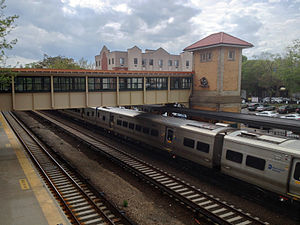Tuckahoe station
Tuckahoe | ||||||||||||||||||||||||||
|---|---|---|---|---|---|---|---|---|---|---|---|---|---|---|---|---|---|---|---|---|---|---|---|---|---|---|
 Looking southwest at Tuckahoe station from the northwest corner of Main Street and Oak Avenue | ||||||||||||||||||||||||||
| General information | ||||||||||||||||||||||||||
| Location | 1 Depot Square (Main Street @ Oak Avenue) Tuckahoe, NY, 10707 | |||||||||||||||||||||||||
| Coordinates | 40°57′02″N 73°49′42″W / 40.9505°N 73.8284°W | |||||||||||||||||||||||||
| Line(s) | ||||||||||||||||||||||||||
| Platforms | 2 side platforms | |||||||||||||||||||||||||
| Tracks | 3 | |||||||||||||||||||||||||
| Connections | ||||||||||||||||||||||||||
| Construction | ||||||||||||||||||||||||||
| Parking | 314 spaces | |||||||||||||||||||||||||
| Other information | ||||||||||||||||||||||||||
| Fare zone | 3 | |||||||||||||||||||||||||
| History | ||||||||||||||||||||||||||
| Opened | 1844[1] | |||||||||||||||||||||||||
| Rebuilt | 1901, c. 1912, 1989 | |||||||||||||||||||||||||
| Electrified | 700V (DC) third rail | |||||||||||||||||||||||||
| Passengers | ||||||||||||||||||||||||||
| 2006 | 408,876 | |||||||||||||||||||||||||
| Services | ||||||||||||||||||||||||||
| ||||||||||||||||||||||||||
The Tuckahoe Metro-North Railroad station serves the residents of the village of Tuckahoe, New York via the Harlem Line. It is 16 miles (25.7 km) from Grand Central Terminal. As of August 2006, daily commuter ridership was 1,378 and there are 314 parking spots.[2] This station is located in the Zone 3 Metro-North fare zone.
History
The New York and Harlem Railroad laid tracks through Tuckahoe during the mid-1840s, and evidence of a station in Tuckahoe can be found at least as far back as the 1850s.[3][4] The current Tuckahoe station building was originally built in 1901, by the New York Central Railroad, and was given an additional baggage elevator approximately in 1912.[5] The station continued to serve commuters without much change until the New York Central merged with rival Pennsylvania Railroad to form Penn Central in 1968. As Penn Central was facing bankruptcy, the Metropolitan Transportation Authority began subsidizing service in 1970, and high-level platforms were constructed to accommodate the new M1A electric MU cars being delivered at the time. Operation of the railroad continued and was passed on to Conrail in 1976. Metro-North took over direct operation in 1983.
In the Spring of 1989, the platforms were reconstructed, along with those of Fleetwood, Bronxville, and Crestwood stations.[6] The baggage and freight elevators were also converted into passenger elevators. Along with Hartsdale and Scarsdale, it is one of three stations on the Harlem Line that features a Starbucks coffee shop inside its station building, a location which opened in June 2006.
Station layout
This station has two high-level side platforms, each 12 cars long.
| M | Mezzanine | Crossover between platforms |
| P Platform level |
Side platform, doors will open on the right | |
| Track 4 | ← Harlem Line toward Grand Central (Bronxville) | |
| Track 2 | ← Harlem Line does not stop here → | |
| Track 1 | Harlem Line toward North White Plains, Southeast or Wassaic (Crestwood) → | |
| Side platform, doors will open on the right | ||
| Street level | Exit/entrance, parking, buses | |
References
- ^ Grogan, Louis V. (1989). The Coming of the New York and Harlem Railroad. Self-Published. p. 14. ISBN 0-962120- 65-0.
- ^ New York Times 2006 Metro-North commuuter rail info
- ^ Tuckahoe History Committee (Village of Tuckahoe: Official Website) Archived 2014-07-03 at the Wayback Machine
- ^ 1858 New York and Harlem Railroad Map (I Ride the Harlem Line)
- ^ Tuckahoe Station (Library of Congress: American Memory) Archived 2014-08-12 at the Wayback Machine
- ^ Harlem Line Schedule History (iRide the Harlem Line)
External links
 Media related to Tuckahoe (Metro-North station) at Wikimedia Commons
Media related to Tuckahoe (Metro-North station) at Wikimedia Commons- Metro-North Railroad - Tuckahoe
- List of upcoming train departure times and track assignments from MTA
- Tuckahoe Station and vicinity during the April 16, 2007 Nor'easter (Flickr)
- Tuckahoe Metro-North Station (TheSubwayNut)
- Station House from Google Maps Street View
